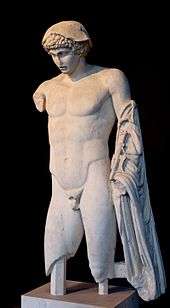Hermes Ludovisi
The Hermes Ludovisi,[1] also formerly known as Mercurio Oratore ("Mercury the Orator"),[2] is a Hellenistic sculpture of the god Hermes in his form of Hermes Psychopompus. It is made of Italic marble and is a somewhat slick[3] 1st-century AD Roman copy after an inferred bronze original of the 5th century BC which is traditionally attributed to the young Phidias, ca 440 BC,[4] or alternatively called "Myronic".[5] Its model is among the earliest sculptural representations of Hermes as beardless and youthful.[6] It was acquired by Cardinal Ludovico Ludovisi for the Ludovisi collection and is now on show at the Palazzo Altemps.


A variant on a somewhat reduced scale, found in Anzio, is conserved in the Museo Nazionale Romano, Palazzo Massimo alle Terme. As in other free Roman-era copies, there are variations in the shaping of the soft-brimmed petasos Hermes wears and the angle of the kerykeion in his left hand.
Notes
- Illustrated in M. Bieber, Ancient Copies, 1971, p. 41 fig.78; W. Fuchs, Die Skulptur der Griechen, 1969, fig. 73; G. Lippold, Die Griechische Plastik: Handbuch der Archäologie, 1950, VI. pt. 3.1, p. 179, pl. 63.2; Helbig, Führer durch die öffentlichen Sammlungen klassischer Altertümer in Rom 4th ed., 1963-72, no. 2326.
- The rhetorically gesturing right arm of the Ludovisi sculpture, however, is a restoration.
- "Mechanical", according to Brunilde Sismondo Ridgway, reviewing Enrico Paribeni, Museo Nazionale Romano: Sculture Greche del V secolo: originali e reliche, 1953, in American Journal of Archaeology 59.1 (January 1955:74-75)
- A suggestion first put forward by Botho Graef, "Athenakopf in Neapel", in Carl Robert, ed., Aus der anomia: archaeologische beitraege, 1890, p. 69.
- E.g. by Amelung.
- "This is, I believe, the earliest representation of Hermes as youthful and beardless" (C. K. Jenkins, "The Reinstatement of Myron-II" The Burlington Magazine for Connoisseurs 50 No. 289 (April 1927:189-196) p. 190).
| Wikimedia Commons has media related to Hermes Ludovisi. |